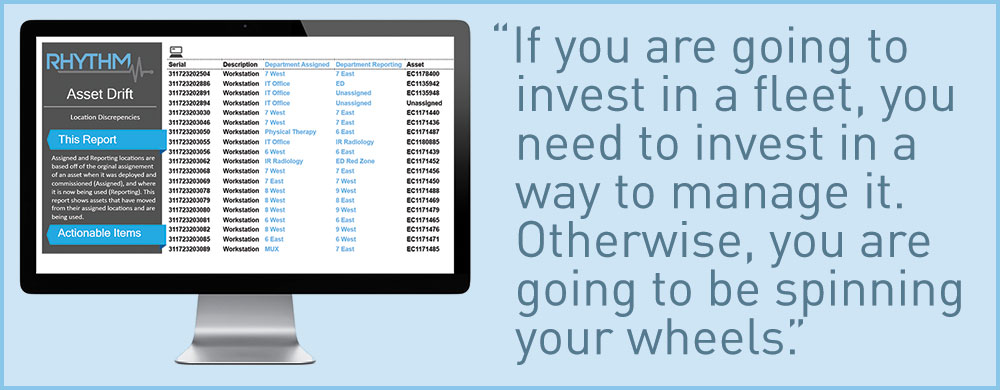
Enovate Medical engaged with an 830-bed hospital and School of Medicine campus in North Carolina.
With over 600 hospital residents seeking a comprehensive clinical learning experience, the young physicians are also among the major users of the hospital’s fleet of 115 Enovate Medical mobile workstations.
Project Highlights
- 115 Envoy workstations on wheels deployed
- 200+ MobiusPower batteries purchased
- Rhythm asset management system implemented for WoW fleet and batteries
- Reallocation of 10 workstations based on usage and location reporting
Challenges
To better manage its workstation fleet, the hospital system recently implemented Rhythm – Enovate Medical’s cloud-based system to remotely monitor and manage mobile EHR workstations for real-time visibility. Shortly after implementation, the hospital campus had an urgent need for ten additional workstations at one of its secondary locations. But instead of purchasing new workstations, the system used Rhythm to see if they could find ten rarely used units.
The Director of IT Service Delivery described how Rhythm eliminated the need to buy new workstations:
“We had some issues at one of our ancillary hospitals where we needed to redeploy ten carts quickly,” the director explained. “The only way we could identify which carts we could take was based on utilization rates. If we were to ask the nurses, they might say take them because they
don’t use them that often even though the resident physicians use them all the time.”
Utilization Reporting – “When we looked in Rhythm’s reporting, we could sort the list by the utilization rates,” he continued. “Some carts were used 13 hours a day, some 10 minutes, and others were effectively abandoned. The highest utilized carts were in the ICU, so we stayed away from them. We were able to identify and locate the lowest-utilized carts and send them to our other location.”
Location Reporting – With real-time drift reports and abandoned workstation reports, Rhythm can report a workstation’s actual location versus its assigned location, a big advantage for the system because resident physicians tend to travel further distances than nurses.
“A workstation might start the day on Five North and finish the day four buildings away at the Cancer Center,” the director explained. “They are constantly on the move.”
Rhythm also offers API integration with existing IT service management systems to streamline the maintenance cycle. “We outsourced our desktop support to a third-party. I showed one of their technicians the reports from Rhythm and he was dumbfounded, saying ‘Where has this been all my life?’ He had no idea how we were finding all these carts.”
Predictive Analytics for Assets – The hospital system’s clinical workflows require a mobile solution which includes 115 workstations with 230 MobiusPower swappable batteries. According to the director, “In healthcare, you want to be as predictive and proactive as you can. These batteries are consumables. Without Rhythm, how would you know the status of batteries and what to budget for when they are at their end of life?” Rhythm’s battery planning calendar provides the biggest payoff giving the IT team real-time visibility for timely and accurate budgeting and optimizing its clinical workflows.
Right-sizing EHR Workstation Fleets – Rhythm also plays a key role in the hospital’s lean initiative to identify assets that aren’t adding value for patients. “What we’re finding is that the CMO, CIO and CFO are all concerned with right-sizing the fleet and putting the carts in the right location,” he explained. “Everybody wants a better bedside documentation strategy, but nobody wants to buy more carts. When they look at the reporting, they realize that 45 minutes a day is not a good use for a $6000 fully-provisioned cart.* Underutilized carts are put to better use by pulling them off the floor completely and holding them in reserve. If the ICU has an urgent need for work-stations, Rhythm would allow us to redeploy our workstations to quickly meet the clinical need.” Similarly, Enovate Medical’s Uptime™ Service Programkeeps clinical staff up and running with Ready Replacements and takes the maintenance burden off over-taxed IT resources.
Return on Investment – Bottom line, Rhythm delivers a tangible return on investment. “Rhythm is a very small investment to gain total visibility into your fleet,” the director concludes. “If you are going to invest in a fleet, you need to invest in a way to manage it. Otherwise, you are going to be spinning your wheels.” The hosptial system has signed on for another year of Rhythm licensing for their fleet.


